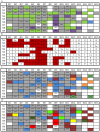Sampling strategies and biodiversity of influenza A subtypes in wild birds
- PMID: 24599502
- PMCID: PMC3944928
- DOI: 10.1371/journal.pone.0090826
Sampling strategies and biodiversity of influenza A subtypes in wild birds
Abstract
Wild aquatic birds are recognized as the natural reservoir of avian influenza A viruses (AIV), but across high and low pathogenic AIV strains, scientists have yet to rigorously identify most competent hosts for the various subtypes. We examined 11,870 GenBank records to provide a baseline inventory and insight into patterns of global AIV subtype diversity and richness. Further, we conducted an extensive literature review and communicated directly with scientists to accumulate data from 50 non-overlapping studies and over 250,000 birds to assess the status of historic sampling effort. We then built virus subtype sample-based accumulation curves to better estimate sample size targets that capture a specific percentage of virus subtype richness at seven sampling locations. Our study identifies a sampling methodology that will detect an estimated 75% of circulating virus subtypes from a targeted bird population and outlines future surveillance and research priorities that are needed to explore the influence of host and virus biodiversity on emergence and transmission.
Conflict of interest statement
Figures



References
-
- Gao R, Cao B, Hu Y, Feng Z, Wang D, et al.. (2013) Human Infection with a Novel Avian-Origin Influenza A (H7N9) Virus. N Engl J Med: 130411140151005. Available: http://www.nejm.org/doi/abs/10.1056/NEJMoa1304459. Accessed 12 April 2013. - DOI - PubMed
-
- OIE (World Organisation for Animal Health) (2014) Information received on 18/01/2014 from Dr TaeYung Kim, Director General, Livestock Policy Bureau, Ministry for Food, Agriculture, Forestry & Fisheries, Sejong-Si, Korea (Rep. of). Available: http://www.oie.int/wahis_2/public/wahid.php/Reviewreport/Review?page_ref.... Accessed 10 February 2014.
-
- Turmelle AS, Olival KJ (2009) Correlates of viral richness in bats (order Chiroptera). Ecohealth 6: 522–539. Available: http://www.ncbi.nlm.nih.gov/pubmed/20049506. Accessed 26 October 2012. - PMC - PubMed
-
- Morse SS, Mazet JA, Woolhouse M, Parrish CR, Carroll D, et al.. (2012) Prediction and prevention of the next pandemic zoonosis. Lancet 380: 1956–1965. Available: http://linkinghub.elsevier.com/retrieve/pii/S0140673612616845. Accessed 2 December 2012. - PMC - PubMed
-
- Dove ADM, Cribb TH (2006) Species accumulation curves and their applications in parasite ecology. Trends Parasitol 22: 568–574. Available: http://www.ncbi.nlm.nih.gov/pubmed/17035087. Accessed 7 March 2012. - PubMed
Publication types
MeSH terms
Grants and funding
LinkOut - more resources
Full Text Sources
Other Literature Sources
Medical

